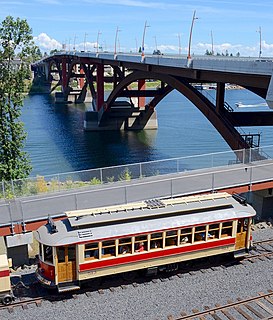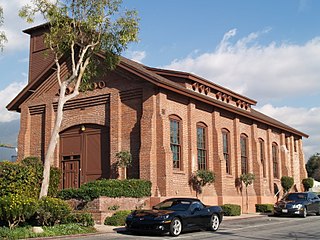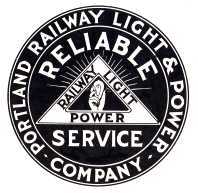
The Willamette Shore Trolley is a heritage railroad or heritage streetcar that operates along the west bank of the Willamette River between Portland and Lake Oswego in the U.S. state of Oregon. The right-of-way is owned by a group of local-area governments who purchased it in 1988 in order to preserve it for potential future rail transit. Streetcar excursion service began operating on a trial basis in 1987, lasting about three months, and regular operation on a long-term basis began in 1990. The Oregon Electric Railway Historical Society has been the line's operator since 1995.

The Yakima Valley Transportation Company was an interurban electric railroad headquartered in Yakima, Washington. It was operator of the city's streetcar system from 1907–1947, and it also provided the local bus service from the 1920s until 1957.

Pittsburgh Railways was one of the predecessors of the Port Authority of Allegheny County. It had 666 PCC cars, the third largest fleet in North America. It had 68 streetcar routes, of which only three are used by the Port Authority as light rail routes. With the Port Authority's Transit Development Plan, many route names will be changed to its original, such as the 41D Brookline becoming the 39 Brookline. Many of the streetcar routes have been remembered in the route names of many Port Authority buses.

The Pennsylvania Trolley Museum is a museum in Washington, Pennsylvania, dedicated to operation and preservation of streetcars and trolleys. The museum primarily contains historic trolleys from Pennsylvania, but their collection includes examples from nearby Toledo, Ohio; New Orleans, and even an open sided car from Brazil. Many have been painstakingly restored to operating condition. Other unique cars either waiting for restoration or incompatible with the Pennsylvania trolley gauge track are on display in a massive trolley display building. Notable examples on static display include a J.G. Brill “brilliner” car which was introduced as a competitor to the PCC, locomotives, and a horse car from the early days of Pittsburgh’s public transit systems.

The National Capital Trolley Museum (NCTM) is a 501(c)(3) nonprofit organization that operates historic street cars, trolleys and trams for the public on a regular schedule. Located in Montgomery County, Maryland, the museum's primary mission is to preserve and interpret the history of the electric street and interurban railways of the National Capital region.

Streetcars or trolley(car)s were once the chief mode of public transit in hundreds of North American cities and towns. Most of the original urban streetcar systems were either dismantled in the mid-20th century or converted to other modes of operation, such as light rail. Today, only Toronto still operates a streetcar network essentially unchanged in layout and mode of operation.
The Mount Hood Railway and Power Company, also known as the Mount Hood Company, initiated hydroelectric development in the Sandy River basin in the U.S. state of Oregon in 1906. Its Bull Run Hydroelectric Project included a powerhouse on the Bull Run River, a tributary of the Sandy River, and a diversion dam on the Little Sandy River, a tributary of the Bull Run River. Water from the dam, which was about 16 feet (4.9 m) high, flowed through a wooden flume about 17,000 feet (5,200 m) long to Roslyn Lake and from there to the powerhouse. The company began using the powerhouse to generate electricity in 1912.

Pacific Electric Railway Company Substation No. 8, also known as the Altadena Substation, is a former traction substation in Altadena, California. It operated under the Pacific Electric Railway and served as the substation for Pasadena area lines.

The Oregon Electric Railway Museum is the largest streetcar/trolley museum in the Pacific Northwest of the United States. It is owned and operated by the Oregon Electric Railway Historical Society and is located in Brooks, Oregon, on the grounds of Powerland Heritage Park.

Council Crest Park is a city park in southwest Portland in the U.S. state of Oregon. Amenities include paved and unpaved paths, a dog off-leash area, picnic tables, public art, a view point, and a wedding site that can be reserved. The 43.51-acre (17.61 ha) park, operated by Portland Parks & Recreation, is open year-round from 5 a.m. to midnight. It was the site of an amusement park from 1907 until 1929.

The Newton Street Railway Carbarn is an historic building located at 1121 Washington Street in the village of West Newton in Newton, Massachusetts. Built in 1890 by the Newton Street Railway Company, it is a rare surviving example of a wood-frame trolley car garage facility, a facility once common in areas served by electrified trolleys. The building has a long two-story central section with extended single-story wings. It has been extensively remodeled and modernized and is now a commercial building with a restaurant, grocery store, and offices.

Cazadero is an unincorporated historic locale in Clackamas County, Oregon, United States. Cazadero was a station on the Estacada interurban railway line of the Portland Railway, Light and Power Company (PRL&P) and later Portland Electric Power Company (PEPCO), near where the power plant of the PEPCO-owned Cazadero Dam was located on the Clackamas River.

The Portland Railway, Light and Power Company (PRL&P) was a railway company and electric power utility in Portland, Oregon, United States, from 1906 until 1924.

The Maine Trolley Cars are a group of 10 rail vehicles, mostly trolley cars, located in Kennebunkport, Maine. The cars were built in various years between 1893 and 1926, and the group was added to the National Register of Historic Places on November 14, 1980. The trolley cars are a small part of the large collection of vehicles at the Seashore Trolley Museum. While the museum's collection of more than 250 vehicles includes ones from several different U.S. states and a few foreign countries, the 10 vehicles in the National Register listing were all operated in the state of Maine at one time.

The Pacific Electric Sub-Station No. 14 is a former traction substation in Santa Ana, California. It was built by the Pacific Electric Railway to provide electricity to run the railway's streetcars in central Orange County, California. The building was added to the National Register of Historic Places in 1983.

The Astoria Riverfront Trolley is a 3-mile (4.8 km) heritage streetcar line that operates in Astoria, Oregon, United States, using former freight railroad tracks along or near the south bank of the Columbia River, with no overhead line. The service began operating in 1999, using a 1913-built streetcar from San Antonio, Texas. As of 2012, the service was reported as carrying 35,000 to 40,000 passengers per year and has been called a "symbol" and "icon" of Astoria. The line's operation is seasonal, normally during spring break and from May through September.

The West Ankeny Car Barns Bay E is a former streetcar carbarn in Portland, Oregon, that is listed on the U.S. National Register of Historic Places. Completed in 1911, it was one of three buildings that collectively made up the Ankeny Car Barns complex of the Portland Railway, Light and Power Company (PRL&P), the owner and operator of Portland's streetcar system at the time. By 1978, the brick building had become the only surviving structure from the Ankeny complex and one of only two surviving remnants of carbarn complexes of the Portland area's large street railway and interurban system of the past, the other being the PRL&P's Sellwood Division Carbarn Office and Clubhouse.

Southeast Bybee Boulevard is a light rail station in Portland, Oregon, United States, served by TriMet as part of the MAX Light Rail system. It is the 14th station southbound on the Orange Line, which operates between downtown Portland, Southeast Portland, and Milwaukie. The grade-separated island platform station adjoins Eastmoreland Golf Course and Crystal Springs Rhododendron Garden to the east and Westmoreland's park of the same name to the west. Its entrances are located on the Bybee Bridge, which spans Southeast McLoughlin Boulevard, the light rail tracks, and Union Pacific Railroad (UP) freight tracks and connects Portland's Sellwood-Moreland and Eastmoreland neighborhoods.

Hawthorne Boulevard is an east–west street in Portland, Oregon and the dividing line between multiple neighborhoods, although "Hawthorne" is often itself considered its own neighborhood. The street stretches from the Willamette River on the west,, and 92nd Avenue on the east. Mount Tabor blocks the street between 60th Street and 72nd Avenue. Hawthorne Boulevard is a principal street west of 50th Avenue and a residential street to the east. The most famous portion of Hawthorne Boulevard is between 29th Avenue and Cesar Chavez Boulevard which serves as a cultural hot spot for Portland's hippie movement. This section of the street is filled with local businesses, boutiques, restaurants, and gift stores, as well as the first Fred Meyer grocery at 36th and Hawthorne, and a bakery at 12th and Hawthorne. It the grocery closed in the 1930s. Hawthorne Boulevard is often compared to Haight Street in San Francisco due to the similar culture of both streets. The street is named for Doctor James C. Hawthorne, a politician and physician. Dr. Hawthorne donated land for the Oregon Hospital for the Insane near the modern day Colonel Summers Park in 1862. The Hospital for the Insane is often called the Hawthorne Asylum, and the street, originally named U Street, took on the moniker Asylum Avenue. The Asylum closed in 1883, and an ordinance was passed to rename the street to Hawthorne Avenue in 1888.
























